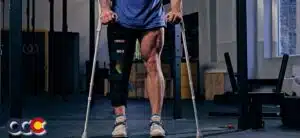Ankle injuries are very common. Most ankle injuries result from straining one of two ankle ligaments (the anterior talofibular ligament and the calcaneofibular ligament.) Many ankle ligament injuries resolve with conservative care such as air casts, activity limits, and medication that treats pain and reduces inflammation. But some people experience repeated ankle sprains, incomplete rehabilitation, or an ankle injury that never fully recovers, which can result in lengthened ligaments and ultimately produce ankle instability. For athletes – or anyone with looser than average ligaments – the likelihood of an ankle injury resulting in ankle instability is elevated, and the risk increases with each recurrence.
How can I tell if I have ankle instability?
“Pain, swelling, and tenderness in the joint – both during movement and while stationary – can be signs of possible ankle instability,” says Dr. Alan Ng, Advanced Orthopedic foot and ankle surgeon. “If your ankle slips or turns frequently in athletic movements or while walking on uneven surfaces, it’s a good idea to seek medical evaluation and treatment.”
Ankle instability is diagnosed through a physical examination and imagery that reveals mechanical instability. A foot and ankle specialist will look for an excess range of motion based on various benchmarks. An unstable ankle will tilt as much as 15-20 degrees (3-4 times the tilt of a healthy ankle).
Conservative Treatments
Conservative treatments for ankle instability are focused on increasing the strength of the outer ankle muscles. Stronger muscles provide additional joint stability. The paradox for many athletes with ankle instability, however, is that since they already possess greater than average muscle strength, there are fewer effective conservative treatments for ankle instability.
Braces, taping, and muscle development are often more effective treatments for patients with a casual or recreational activity level or in circumstances where conservative aid is employed to support short-term performance. If you are a competitive athlete, dancer, or if ankle instability does not respond to conservative care [e.g., chronic pain in everyday activity,] surgical repair may be necessary.
Ankle Instability Surgical Options
“Surgical treatments for ankle instability focus on the repair or replacement of damaged ankle ligaments,” says foot and ankle surgeon Dr. Keith Jacobson. “The degree of damage within the ankle, the patient’s weight and activity level, and the patient’s ankle injury history all influence which surgical procedure is best suited for each patient.”
The extent of tissue damage within the ankle is the first factor assessed. The health of the existing ligament dictates whether surgery will involve the use of the patient’s own tissue or an allograft (donor’s tendon) and which surgical procedure is the best fit.
Anatomic Reconstruction vs. Non-anatomic Ligament Repair
Surgical treatments for ankle instability are either anatomic or non-anatomic ankle ligament repair.
Anatomic reconstruction is the shortening and tightening of a stretched ligament. Generally, anatomic reconstruction is the preferred method of correcting ankle instability. It is a simple procedure that preserves complete joint mobility, has a shorter recovery window, and has a very high success rate.
During the procedure, an incision is made on the ankle to expose the joint capsule. An initial arthroscopic examination of the ligament may be performed before making a bigger incision to assess and confirm the optimal corrective action. The stretched ligament is repaired by surgical reduction and suturing and may be reinforced with surgical anchors. The range of motion is then evaluated before closing the incision. The result, upon healing, is a shorter and tighter ankle ligament that maximizes mobility.
If the patient’s ankle ligament is too badly stretched or damaged, a non-anatomic ligament repair (reconstructive tenodesis) uses a tendon or a graft to replace the damaged ligament. The process requires a larger incision and longer recovery and carries the risk of possible nerve irritation.
The incision on the ankle allows for the harvesting of a tendon or the insertion of a donor’s tendon. Drill holes are created on the heel and calf bones to attach the graft. The range of motion with the new graft is evaluated, and the incision is closed. If necessary, the fibrous bands of facia surrounding the ankle (the retinaculum) can also be tightened during the same procedure to bolster ankle stability further and guard against re-injury.
Recovery
Following either procedure, the ankle is immobilized with a splint. Patients should expect strict weight-bearing activity limits for the first two weeks. A cast or boot is then used for the following two to four weeks before beginning physical therapy. Generally, physical therapy begins six weeks following surgery. Ankle supports should be expected for the first three months following surgery.
Most patients transition from a brace and into normal activities following ten weeks of a personalized progressive recovery plan. Diligent rehabilitation efforts are vital to successful outcomes. By following a prescribed rehabilitation plan, patients can maximize ankle function, range of motion, and joint stability.
Long-term outcomes for ankle instability are generally very positive when properly diagnosed and treated. If you are experiencing chronic ankle instability in your daily activity or competitive sport, the foot and ankle experts at Advanced Orthopedics and Sports Medicine Specialists can provide you with the best treatment options that keep you moving.










